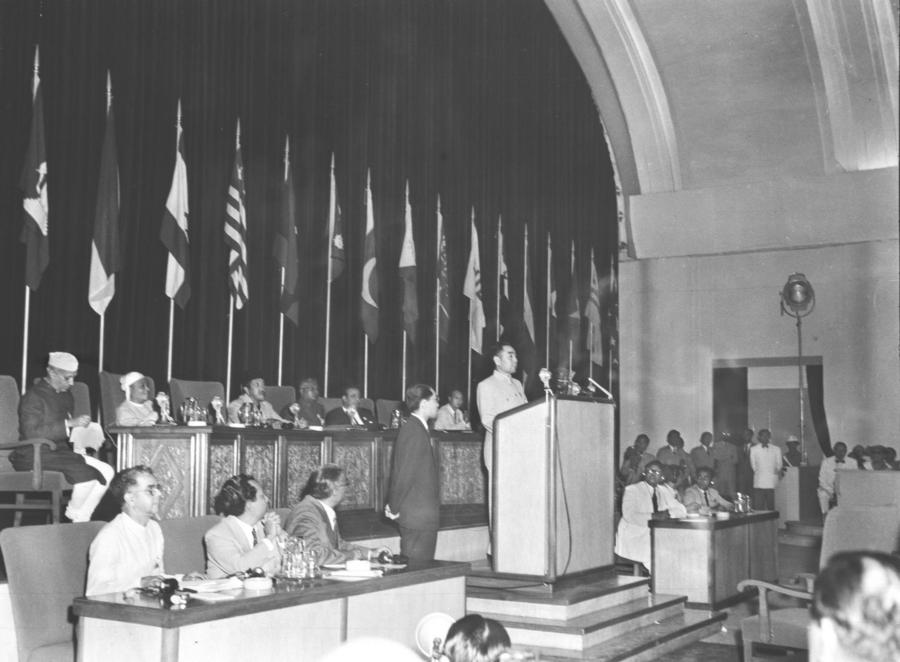
蒋敦豪豪士 | 8k8 apk | Updated: 2024-07-03 09:40:46

On June 28 and 29, 1954, China issued two joint statements with India and Myanmar, respectively, confirming their commitment to the Five Principles of Peaceful Coexistence.
A year earlier, then Chinese premier Zhou Enlai had summarized the Chinese traditions of "peace is most precious", "harmony without uniformity" and "universal love and nonaggression" and put forward the principles of mutual respect for sovereignty and territorial integrity, mutual nonaggression, mutual noninterference in internal affairs, equality and cooperation, and peaceful coexistence.
Then Indian prime minister Jawaharlal Nehru said, "If these principles were recognized in the mutual relations of all countries, then indeed there would hardly be any conflict and certainly no war."
In the past 70 years, the five principles have flourished and become the basic norm governing international relations, though not all countries have implemented them in spirit. China itself has defined, developed and observed the principles to the full, injecting constant hope in the world's pursuit of sovereign equity, common security and development, fairness and justice.
The principles are well rooted in international law largely because they embody the values of sovereignty, justice, democracy and rule of law, in a departure from the divisive mentality of bloc alliances, avoiding zero-sum game of losers and winners, and encouraging win-win cooperation.
At the Bandung Conference in 1955, developing countries wove the five principles into the Ten Bandung Principles of the nonaligned movement, guiding the Global South onto the paths of sovereign independence, equity and common development, away from the bullying and bloc confrontation mindset.
Throughout the decades, China has remained committed to the principles, adhering to them and making them the cornerstone of its foreign policy. It has emphasized the principles on multiple occasions and at different national, regional and global forums.
China is not using these principles as rhetoric, instead, it has taken practical actions to create the path of peaceful coexistence. During the height of global tension, late Chairman Mao Zedong presented the Three Worlds Theory to describe the Cold War and the role of China, working to protect weak nations from bloc politics and its effects. Over the decades, China has never bullied any country, but only interacted respectfully with other nations, based on the concept of sovereign equality.
China always pushes for solving disputes through dialogue. For example, after the USSR attacked Afghanistan, China urged all parties to solve the issue peacefully and through dialogue. In North Asia, China initiated the Six-Party Talks, which stands in contrast to the tense situation at present in the Korean Peninsula.
Moreover, China is building partnerships with countries by adhering to the principle of noninterference. For example, China has been working with Middle Eastern countries for decades, but never picked a side in regional conflicts or interfered in their economic or government models. Pakistan is another example. China and Pakistan are working closely and are considered the iron brothers, yet China has never interfered in Pakistan's internal affairs.
It is pertinent to highlight here that with during the transition from a middle power to a great power, China's resolve to adhere to the five principles has become stronger. There are many examples of China working to implement the principles.
In the Palestinian-Israeli conflict, China has promoted ceasefire and dialogue for long. In his BRICS summit address in November 2023, President Xi Jinping made three points. First, all parties should cease fire and release hostages; second, humanitarian aid channels should be guaranteed; third, international measures should help avoid escalation of the conflict in the Middle East. On May 6, Xi told the world in Paris that Palestine should be supported to become an official member of the United Nations, talks of two-state solution be reignited, and the people of Palestine should enjoy due national and international rights.
China is applying an identical formula toward an eventual resolution of the Russia-Ukraine conflict. The peace plan by China is a comprehensive proposal that covers all important areas. It asks both parties to respect each other's sovereignty and work for the betterment of people, and emphasizes building a security framework, which must be representative of the needs of all concerned parties. As it was mentioned in the second point of the peace plan, all parties should help forge a balanced, effective and sustainable European security architecture, following the vision of common, comprehensive, cooperative and sustainable security and bearing in mind the long-term peace and stability of the world. Further, efforts must be put forward to oppose military blocs and confrontation.
These examples prove that China has been a trustworthy partner and a positive contributor in striving to create a peaceful world by resolving issues through dialogue. Despite the fact that China has become a great power, it is not interfering in or dictating to other countries, and is the only major power whose leaders successively pledge never to seek hegemony.
Rather, China is trying to build partnerships and assist in resolving disputes and ending conflicts, a proven force for global peace that is a beacon of hope for all peoples.
The author is CEO of the Asian Institute of Eco-civilization Research and Development in Pakistan. The views do not necessarily reflect those of China Daily.

